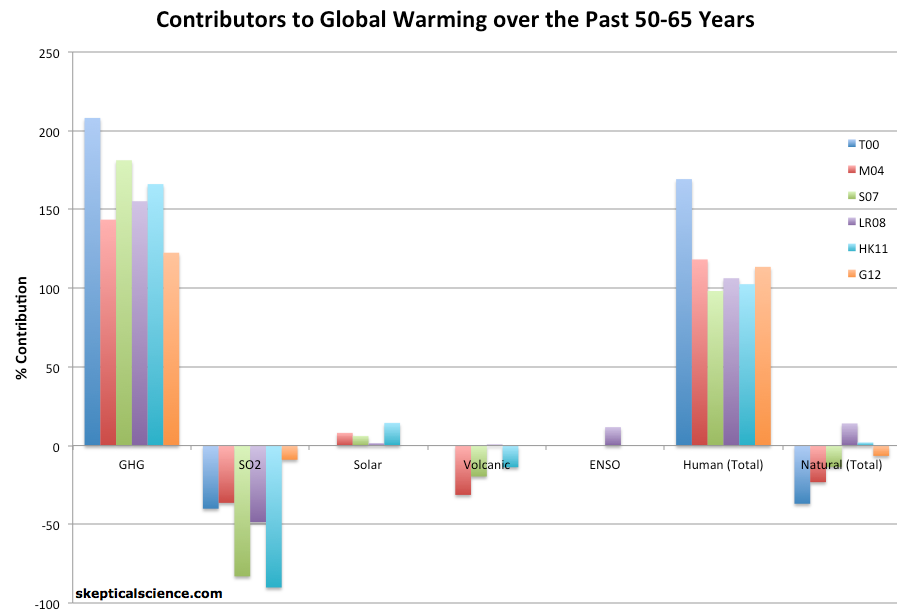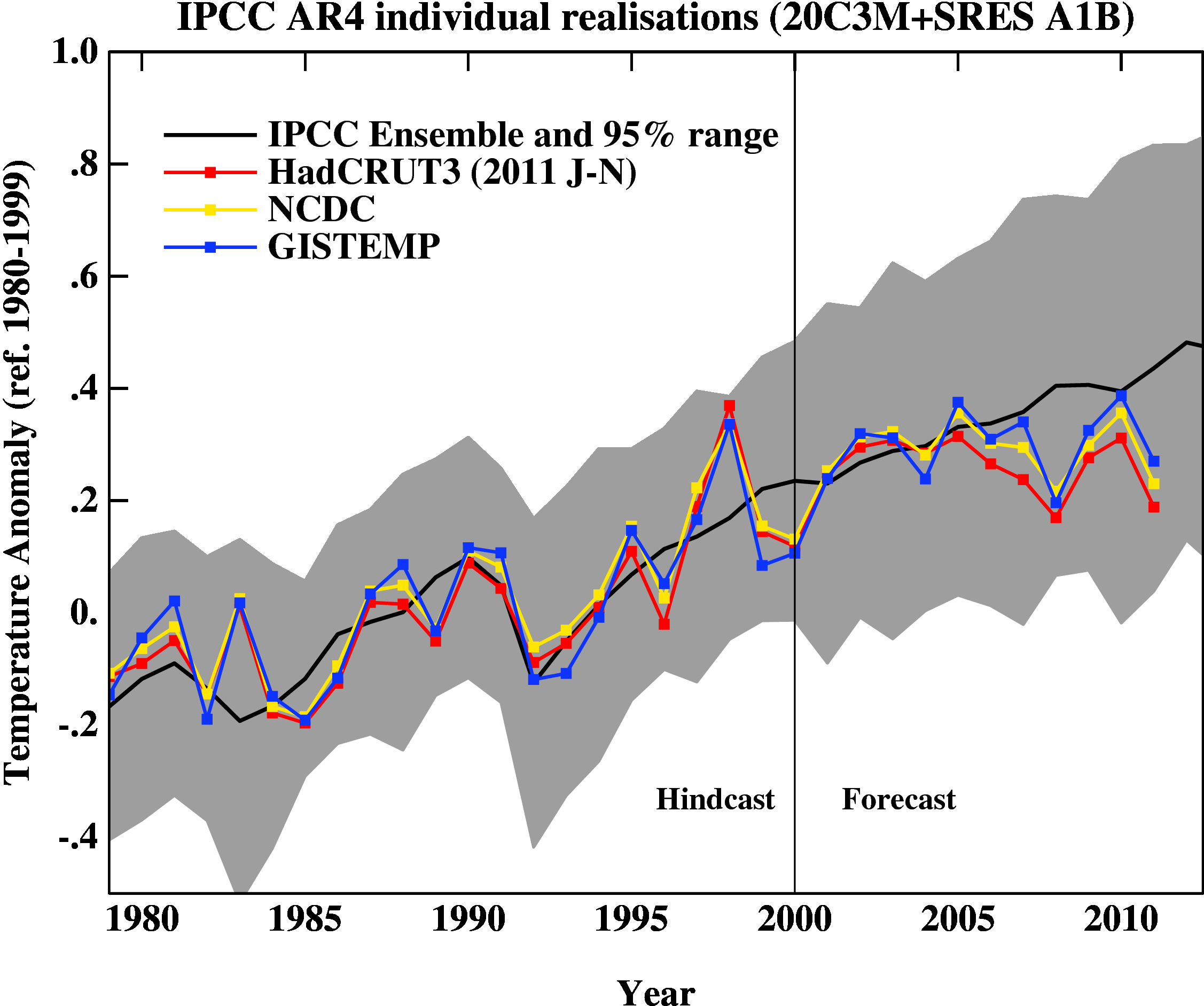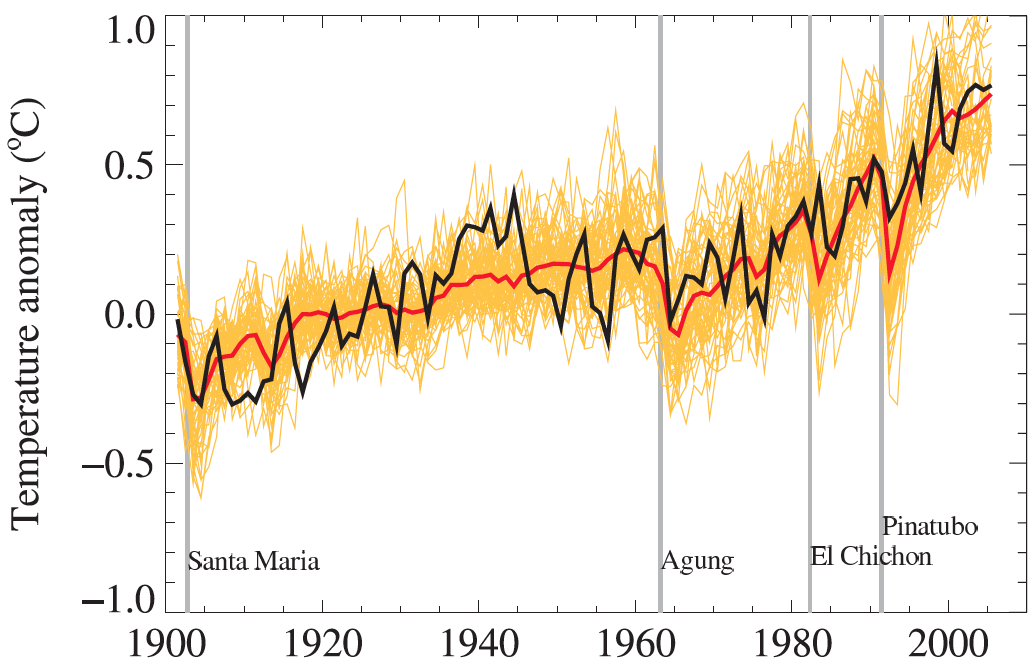The Certainty Monster vs. The Uncertainty Ewok
Posted on 2 March 2012 by dana1981
In a recent post on her blog, climate scientist Judith Curry discussed relatively recent global surface temperature changes, and the causes of those changes. Curry put forth 3 "hypotheses" (one of which is actually a theory, not a hypothesis [see if you can pick out which]):
I. IPCC AGW hypothesis
II. Multi-decadal oscillations plus trend hypothesis
III: Climate shifts hypothesis
Note that in all three of these theories/hypotheses, there exists an underlying (human-caused) warming trend, and thus what Curry is really discussing is how to best explain the short-term noise in the climate system. However, Curry incorrectly states:
"Each of these three hypotheses provides a different interpretation of the 20th century attribution and has different implications for 21st century climate."
As noted above, the attribution of the observed global warming is not the question here. In each case, the long-term warming is attributed to the external radiative forcing, which has been dominated by human greenhouse gas emissions (Figure 1).
Figure 1: Percent contributions of various effects to the observed global surface warming over the past 50-65 years according to Tett et al. 2000 (T00, dark blue), Meehl et al. 2004 (M04, red), Stone et al. 2007 (S07, green), Lean and Rind 2008 (LR08, purple), Huber and Knutti 2011 (HK11, light blue), and Gillett et al. 2012 (G12, orange).
Curry references work by Tsonis and Swanson as a good example of hypothesis III (climate shifts), and says:
"Hypothesis III is the hypothesis that I find most convincing"
However, as Swanson put it:
"What do our results have to do with Global Warming, i.e., the century-scale response to greenhouse gas emissions? VERY LITTLE, contrary to claims that others have made on our behalf."
It's certainly valid to examine why the warming of global surface temperatures is dampened or accelerated over short timeframes, but Curry has mistaken this short-term question with the physical cause of the long-term warming, which is dominated by the radiative forcing from human greenhouse gas emissions.
Curried Cherries
In the same blog post, Curry also attempts to defend those who cherry pick convenient starting points and short-term data to argue that global warming has stopped.
"There has been slight warming during the past 15 years. Is it “cherry picking” to start a trend analysis at 1998? No, not if you are looking for a long period of time where there is little or no warming, in efforts to refute Hypothesis I."
Looking for a period of time (and no, 15 years is not a "long" period) to support a specific conclusion is by definition cherry picking. Starting in 1998, which was the strongest El Niño event in a century (and which was only 14, not 15 years go), is cherry picking.
As we discussed in response to Vahrenholt's similar claims, virtually every non-greenhouse gas effect over the past decade has acted in the cooling direction, and yet the planet has continued to warm. Again, it's certainly worthwhile to look at those other effects, which climate scientists are doing, but we should not mistake short-term and long-term effects. Curry is once again going down the up escalator.
The Uncertainty Ewok
Curry often likes to emphasize what she has termed the "uncertainty monster," which generally involves exaggerating climate science uncertainties, and claiming that the IPCC is imprecise in its discussions about uncertainties (a claim examined by SkS here and by Hegerl et al. here). Strangely, in perpetuating the myth that Earth hasn't warmed as much as expected, Curry completely disregards the uncertainty range:
"Is the first decade+ of the 21st century the warmest in the past 100 years (as per Peter Gleick’s argument)? Yes, but the very small positive trend is not consistent with the expectation of 0.2C/decade provided by the IPCC AR4. In terms of anticipating temperature change in the coming decades, the AGW dominated prediction of 0.2C/decade does not seem like a good bet, particularly with the prospect of reduced solar radiation."
It's simply inaccurate to describe the recent warming as inconsistent with IPCC AR4 projections, as we recently discussed with regards to Scafetta's widget, and as Gavin Schmidt recently demonstrated (Figure 2).
Figure 2: Annual mean global surface temperature anomalies from the IPCC AR4 models plotted against the surface temperature records from the HadCRUT3v, NCDC and GISTEMP products. Everything has been baselined to 1980-1999 (as in the 2007 IPCC report) and the envelope in grey encloses 95% of the model runs.
As Figure 2 shows, the observational data fall well within the envelope of climate model runs. While the most likely trend over the next few decades is 0.2°C surface warming per decade, there are going to be some short periods with slower surface warming, and some with faster warming.
Skeptical Science's Dikran Marsupial has described the uncertainty monster as an "uncertainty Ewok," because while there are of course climate uncertainties, some of which are quite substantial, science and statistics have developed and refined sensible approaches to dealing with them and they are nothing to be scared of. The existence of significant uncertainties does not mean we don't know anything or that no conclusions can be drawn. We understand the main drivers of the climate reasonably well, and the climatologists (and the IPCC) consistently take the remaining uncertaities into account when drawing conclusions. The uncertainty interval of the AR4 model projections provides a good example of dealing with the uncertainty ewok; they allow us to conclude that a long term (e.g. 30+ years) cooling trend would be inconsistent with our understanding of climate physics (under this scenario), but the level of uncertainty in the projections prevent us from drawing strong conclusions about the expected trend for the next decade, at least using the last generation of climate models. 
Figure 3: Phillip, the Uncertainty Ewok
The Certainty Monster
In another recent post, Curry looks at the main global surface temperature influences (anthropogenic, volcanic, solar, ocean cycles) and speculates about their effects on temperature from 2015 to 2050.
"It is a plausible scenario that we will continue to see relatively flat trend in temperature for the coming decade. The most recent climate shift has been argued (Tsonis et al) to have occurred 2001/2002. A climate shift would probably occur sometime before 2050, although whether the shift trends warmer or cooler remains to be seen. At some point a warming trend would likely resume. To me this seems like a more plausible scenario than the 0.2C/decade projection to 2050 from AR4."
However, we must once again note that Swanson and Tsonis do not dispute the underlying human-caused global warming trend. In fact, Swanson and Tsonis (2009) noted that a climate with large internal variability will also tend to be more sensitive to external forcings like greenhouse gases:
"It is straightforward to argue that a climate with significant internal variability is a climate that is very sensitive to applied anthropogenic radiative anomalies (c.f. Roe [2009]). If the role of internal variability in the climate system is as large as this analysis would seem to suggest, warming over the 21st century may well be larger than that predicted by the current generation of models..."
Curry argued that the right combination of solar and volcanic activity and internal variability could potentially combine to offset human-caused warming for the next ~40 years. While this is hypothetically possible (for example, if there were numerous large volcanic eruptions), it is a highly implausible scenario.
By 2050, atmospheric CO2 will likely be around 500 parts per million (ppm), which corresponds to a 1.3 Watts per square meter (W/m2) radiative forcing compared to today's level of about 390 ppm, or approximately 0.7°C transient surface warming over the next 40 years just from CO2. In comparison, a change in TSI from today's levels to those of a Maunder Minimum (the largest solar minimum in the past several centuries) would only cause a radiative forcing of 0.17 to 0.44 W/m2, or about 0.1 to 0.25°C transient cooling. The El Niño Southern Oscillation (ENSO) generally does not cause more than 0.2 to 0.3°C surface temperature change on decadal timescales, and barring repeated closely-spaced large eruptions, volcanic effects on surface temperature are short-lived.
Thus to offset the large human-caused radiative forcing up to 2050 would require a new Maunder Minimum, a preponderance of La Niñas (which would shift the warming to the oceans), and several large volcanic eruptions. This also disregards the warming effects of non-CO2 greenhouse gases, and the likely reduction of human aerosol emissions (and their associated cooling effect), which will cause additional warming over that period. Curry's is not a very likely scenario, to put it lightly.
Curry Misrepresents AGW Theory and IPCC Report
Moreover, Curry talks about selecting "long" timeframes during which global warming is relatively flat to disprove the consensus anthropogenic global warming (AGW) theory. But such a scenario in which a number of non-CO2 influences combine to dampen human-caused warming, as has happened over the past decade or so, does not disprove the AGW theory.
This is demonstrated by Figure 2 above, in which the observed temperatures fall within the envelope of model runs. The AGW theory does not expect perfect 0.2°C surface warming every decade, because climate scientists are aware that short-term influences can align to dampen or amplify the underlying warming trend. Periods of little warming on the order of a decade are entirely expected and consistent with the AGW theory.
Curry further asserts:
"Until the warming from 1910-1940 and the cool period from 1940′s to 1970′s are convincingly explained, I find it difficult to think than [solar forcing and natural internal variability] aren’t important in explaining the variability earlier in the century."
But solar forcing and internal variability did play a role in the 1910-1940 warming, as discussed in the 2007 IPCC report (Chapter 9.4.1.5):
"A number of studies detect a significant natural contribution to early 20th-century warming (Tett et al., 2002; Stott et al., 2003b; Nozawa et al., 2005; Shiogama et al., 2006). Some studies find a greater role for solar forcing than other forcings before 1950 (Stott et al., 2003b), although one detection study finds a roughly equal role for solar and volcanic forcing (Shiogama et al., 2006), and others find that volcanic forcing (Hegerl et al., 2003, 2007) or a substantial contribution from natural internal variability (Tett et al., 2002; Hegerl et al., 2007) could be important. There could also be an early expression of greenhouse warming in the early 20th century (Tett et al., 2002; Hegerl et al., 2003, 2007)."
And the AGW theory and IPCC report have explained the 1910-1940 warming and mid-century cooling (Figure 4).
Figure 4: IPCC AR4 Figure 9.5. Comparison between global mean surface temperature anomalies (°C) from observations (black) and AOGCM simulations forced with both anthropogenic and natural forcings. All data are shown as global mean temperature anomalies relative to the period 1901 to 1950, as observed (black, HadCRUT3) and as obtained from 58 simulations produced by 14 models with both anthropogenic and natural forcings. The multi-model ensemble mean is shown as a thick red curve and individual simulations are shown as thin yellow curves. Vertical grey lines indicate the timing of major volcanic events.
In short, Curry does not accurately represent either the AGW theory or IPCC report.
The Real Uncertainty Monster
While we cannot accurately predict how solar or volcanic effects or internal variability will change in the coming decades, the one thing we can be certain about is that the anthropogenic warming trend will continue its steady rise as long as greenhouse gas emissions continue their upward march, and it is very unlikely the natural effects will be able to offset that human-caused warming for very long.
Climate "skeptics" often need to make a monster out of the uncertainty to avoid the fact that it often simply isn't large enough to make their positions plausible. For the "skeptics," the fact that the remaining uncertainty is insufficient to cast serious doubt on the anthropogenic global warming theory or provide justification against taking action to reduce greenhouse gas emissions - that's the real uncertainty monster.































 Arguments
Arguments

































[dana1981] 'Stork hypothesis' literally made me LOL!